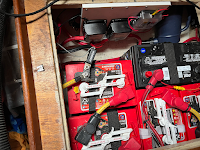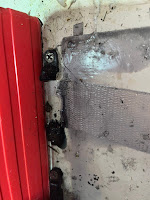 I recently installed a Victron SmartShunt, and a pair of Blue Sea 7701 power relays, to take over the function of the Perko rotating battery bank selector. (I wired them in parallel, leaving the Perko as a backup.)
I recently installed a Victron SmartShunt, and a pair of Blue Sea 7701 power relays, to take over the function of the Perko rotating battery bank selector. (I wired them in parallel, leaving the Perko as a backup.)
Of course this discovery compelled me to pull them all. I replaced the pad eyes with 316 stainless ones, and used plastic buckles to create the loops.
The old plastic stuff came from a kit, sold by marine stores specifically for securing marine batteries, installed by my boatyard -- it's even ABYC approved! Clearly the choice of materials was a poor one! (It's not like there aren't plenty of plastics that will withstand sulfuric acid.) It is well understood that lead-acid batteries sometimes lose some electrolyte, yet these straps fail completely and catastrophically if that not-uncommon condition occurs! Unconscionable! (And it really leaves one to wonder about the value of ABYC product approval.)
To their credit, the ABYC is correct about the dangers of unsecured batteries -- making certain that your marine batteries are indeed secure (and not merely appearing to be that way) is every boater's responsibility. The consequences of unsecured batteries are potentially extreme!Boaters with any reason to suspect any electrolyte has spilled, that these inferior tie-downs are installed, or any other condition that might compromise the hardware used to secure batteries, should take the time to pull them out of the box for a thorough inspection, to check the integrity of both the pad eyes and the straps.
Side note: in my opinion, for a standards organization like the ABYC to put their stamp of approval onto something, they should go to reasonable lengths to simulate real world worst case conditions. For battery tie-downs, that will certainly be used with lead-acid batteries, the materials must be impervious to the electrolyte. Verifying that this is the case is be very easy to do -- I did it to test my new straps. That they clearly did not do so in this case is very disturbing, so I'm calling for transparency into the nature and depth of their testing, when they sign off on products we mariners are trusting with our lives.



